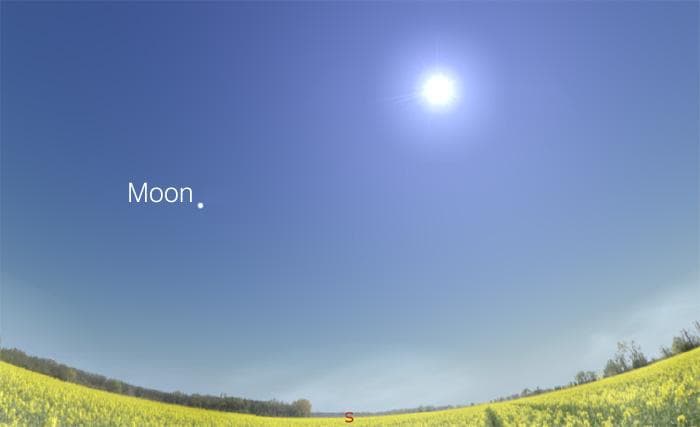
with David Fuller

See Spica during the day
People are surprised that they can see stars during the day that are not the Sun. “What? Really? How is that possible?” It is possible because bright stars are... well, bright! The trick is that you need to know the exact spot to look, because you won't have the crutch of a dark sky to make the star's contrast with the sky as obvious.
So how to find a star in the sky this week? Use the Moon as your guide. On Friday August 29th, the Moon will be a waxing crescent. Now, some people are still surprised that the Moon can be seen during the day, but that's another matter. Even crescent like this shines at magnitude negative nine, more than sufficient to be seen in a clear blue sky.

The first step is to find the Moon in the sky, and you have a window of a couple hours for the easiest spotting of the star. For the first opportunity, look slightly before 3:00 pm EDT/12:00 pm PDT. The Moon will be around 45 degrees east of the Sun along the ecliptic. Now keep in mind that during the day in summer, the ecliptic is much higher in the sky. It is lower in the night-time sky, as the Earth spins to face the opposite direction. But the ecliptic is the line the SUN traces in the sky, and the Sun is high overhead in summer. So look higher for the ecliptic, and the Moon.
Using two hands held out at arm's length, stretch your pinkies and thumbs out to maximum width, forming a giant “W” with your hands. (Learn how to measure distance in the sky here.) The distance across from pinky to pinky is about 45 to 50 degrees. Now, don't ACTUALLY look right at the Sun, but place your right hand's pinky where the Sun is, as the other pinky along the ecliptic, towards the east. Look for the Moon in this area; the thin, narrow crescent should be visible in a clear, transparent sky. Haze and humidity may make it more difficult – and that will also make tracking Spica down more difficult too. So hope for good transparency! The bluer the sky, the better.
IMPORTANT NOTE: DO NOT allow sunlight to enter an unfiltered telescope. Ideally, set up a telescope in shadow so the Sun cannot possibly enter the telescope's open end. If not, tape a shield on the sunward side to be certain no directly sunlight can enter the telescope. DO NOT attempt this is there is ANY chance of sunlight reaching the telesecope lens/mirror. Instant and permanent blindness can result. DO NOT mess around with this!
If you have an equatorial mounted telescope, this is where it can really come in handy, though the declination setting circles will need precision of at least full degrees in order to be useful. If not, use a low power, long focal length eyepiece. Center the Moon in the telescope, and focus it carefully to the best focus you can achieve. Now, this also assumes that you have a good idea of which direction is north, and that your equatorial mount is roughtly polar aligned (within a few degrees or so of the celestial pole).

Now use the slow motion declination cable to rotate the tube south (down). You will only need to move it two degrees, so look at the declination setting circle, and rotate it down that far, and stop. Look in the eyepiece again... Spica should be there. If not, go back to the Moon, use a medium focal length eyepiece, focus again, then rotate south two degrees again. This can darken the sky background slightly, assisting with finding the star. But note that a higher magnification eyepiece also narrows your telescopic field of view. But try that again anyway... find it? Spica is a first magnitude star, and should be visible under transparent skies. Haze and humidity will hamper your efforts!
Another way to find Spica is to wait another two hours. At that time – 5:00 pm EDT / 2:00 pm PDT – the “points” of the crescent Moon make for a good alignment guide. Drawing a line across the points, towards the south, will get you right to Spica, two degrees away. You may even be able to estimate this distance in a finderscope. Remember that the Moon is a half a degree across. So just go four times that far (from the middle of the Moon, just south of Mare Crisium!), and that will place you at Spica. With a one degree field of view eyepiece, you should be able to locate the first magnitude star during the day.

What size telescope to use? Here's a site with more information about seeing objects during the day. But ideally, you'll probably want to use 8" or 10" scope, as they gather more light. That said, it's certainly worth trying with smaller optics, but your chances will be better the more clear/transparent the sky is.
So, if you have clear skies on Thursday, why not give it a try? See if you can find it! And again, PLEASE be sure to exercise the utmost care when using an unfiltered telescope during the day. Set up in an area shaded from the Sun that has a line of sight to the Moon/Spica, to avoid any possibility of sunlight damaging your eyes.
